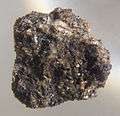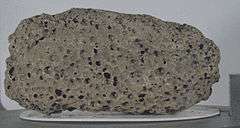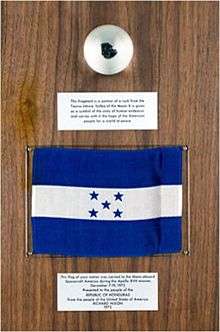Moon rock
Moon rock or lunar rock is rock that is found on the Earth's moon, or lunar material collected during the course of human exploration of the Moon.
Moon rocks on Earth come from three sources: those collected by the US Apollo manned lunar landings from 1969 to 1972; samples returned by three Soviet Luna unmanned probes in the 1970s; and rocks that were ejected naturally from the lunar surface by cratering events and subsequently fell to Earth as lunar meteorites. During the six Apollo landing missions, 2,415 samples weighing 380.96 kilograms (839.87 lb) were collected. Three Luna spacecraft returned with 326 grams (11.5 oz) of samples. Since 1980, over 120 lunar meteorites representing about 60 different meteorite fall events (none witnessed) have been collected on Earth, with a total mass of over 48 kilograms (106 lb). About one third of these were discovered by US and Japanese teams searching for Antarctic meteorites (e.g., ANSMET), with most of the remainder having been discovered by collectors in the desert regions of northern Africa and Oman.
Rocks from the Moon have been measured by radiometric dating techniques. They range in age from about 3.16 billion years old for the basaltic samples derived from the lunar maria, up to about 4.44 billion years old for rocks derived from the highlands.[1] Based on the age dating technique of "crater counting," the youngest basaltic eruptions are believed to have occurred about 1.2 billion years ago,[2] but scientists do not possess samples of these lavas. In contrast, the oldest ages of rocks from the Earth are between 3.8 and 4.28 billion years old.
Almost all lunar rocks are depleted in volatiles and are completely lacking in hydrated minerals common in Earth rocks. In some regards, lunar rocks are closely related to Earth's rocks in their isotopic composition of the element oxygen. The Apollo moon rocks were collected using a variety of tools, including hammers, rakes, scoops, tongs, and core tubes. Most were photographed prior to collection to record the condition in which they were found. They were placed inside sample bags and then a Special Environmental Sample Container for return to the Earth to protect them from contamination. In contrast to the Earth, large portions of the lunar crust appear to be composed of rocks with high concentrations of the mineral anorthite. The mare basalts have relatively high iron values. Furthermore, some of the mare basalts have very high levels of titanium (in the form of ilmenite).[3]
Curation and availability

|
The main repository for the Apollo Moon rocks is the Lunar Sample Laboratory Facility at the Lyndon B. Johnson Space Center in Houston, Texas. For safe keeping, there is also a smaller collection stored at White Sands Test Facility in Las Cruces, New Mexico. Most of the rocks are stored in nitrogen to keep them free of moisture. They are only handled indirectly, using special tools.
Moon rocks collected during the course of lunar exploration are currently considered priceless. In 2002, a safe, containing minute samples of lunar and Martian material, was stolen from the Lunar Sample Building. The samples were recovered; in 2003, during the court case, NASA estimated the value of these samples at about $1 million for 285 g (10 oz) of material.
Naturally transported Moon rocks (in the form of lunar meteorites), although expensive, are widely sold and traded among private collectors.
Goodwill Moon rocks
In 1970, US president Richard Nixon gave presentation samples of Moon rock brought back by Apollo 11 as gifts to 135 countries and 50 US states.
Near the end of their third and final moonwalk, and what would be the last moonwalk of the Apollo program, Apollo 17 astronauts Eugene Cernan and Harrison Schmitt "picked up a very significant rock, typical of what we have here in the valley of Taurus-Littrow... composed of many fragments, of many sizes, and many shapes, probably from all parts of the Moon, perhaps billions of years old" and made a special dedication to the young people of Earth. This rock was later labeled sample 70017.[5] President Nixon ordered the distribution of fragments of the rock to 135 foreign heads of state and the 50 U.S. states. These gifts were distributed in 1973. The fragments were presented encased in an acrylic sphere, mounted on a wood plaque which included the recipients' flag which had also flown aboard Apollo 17.[6]
Many of the presentation Moon rocks are now unaccounted for, having been stolen or lost.
Unmanned sample returns
|
The Soviet Union attempted, but failed to make manned lunar landings in the 1970s, due to failure to develop their N1 rocket, but they succeeded in landing three robotic Luna spacecraft with the capability to collect and return small samples to Earth. A combined total of less than one kilogram of material was returned.
In 1993, three small fragments from Luna 16, weighing 200 mg, were sold for US$ 442,500.
Classification
Moon rocks fall into two main categories: those found in the lunar highlands (terrae), and those in the maria. The terrae consist dominantly of mafic plutonic rocks. Regolith breccias with similar protoliths are also common. Mare basalts come in three distinct series in direct relation to their titanium content: high-Ti basalts, low-Ti basalts, and Very Low-Ti (VLT) basalts.
Highlands lithologies
| Plagioclase | Pyroxene | Olivine | Ilmenite | |
|---|---|---|---|---|
| Anorthosite | 90% | 5% | 5% | 0% |
| Norite | 60% | 35% | 5% | 0% |
| Troctolite | 60% | 5% | 35% | 0% |
| Plagioclase | Pyroxene | Olivine | Ilmenite | |
|---|---|---|---|---|
| High titanium content | 30% | 54% | 3% | 18% |
| Low titanium content | 30% | 60% | 5% | 5% |
| Very low titanium content | 35% | 55% | 8% | 2% |
| Mineral | Elements | Lunar rock appearance |
|---|---|---|
| Plagioclase feldspar | Calcium (Ca) Aluminium (Al) Silicon (Si) Oxygen (O) |
White to transparent gray; usually as elongated grains. |
| Pyroxene | Iron (Fe), Magnesium (Mg) Calcium (Ca) Silicon (Si) Oxygen (O) |
Maroon to black; the grains appear more elongated in the maria and more square in the highlands. |
| Olivine | Iron (Fe) Magnesium (Mg) Silicon (Si) Oxygen (O) |
Greenish color; generally, it appears in a rounded shape. |
| Ilmenite | Iron (Fe), Titanium (Ti) Oxygen (O) |
Black, elongated square crystals. |
Primary igneous rocks in the lunar highlands compose three distinct groups: the ferroan anorthosite suite, the magnesian suite, and the alkali suite.
Lunar breccias, formed largely by the immense basin-forming impacts, are dominantly composed of highland lithologies because most mare basalts post-date basin formation (and largely fill these impact basins).
The ferroan anorthosite suite consists almost exclusively of the rock anorthosite (>90% calcic plagioclase) with less common anorthositic gabbro (70-80% calcic plagioclase, with minor pyroxene). The ferroan anorthosite suite is the most common group in the highlands, and is inferred to represent plagioclase flotation cumulates of the lunar magma ocean, with interstitial mafic phases formed from trapped interstitial melt or rafted upwards with the more abundant plagioclase framework. The plagioclase is extremely calcic by terrestrial standards, with molar anorthite contents of 94-96% (An94-96). This reflects the extreme depletion of the bulk moon in alkalis (Na, K) as well as water and other volatile elements. In contrast, the mafic minerals in this suite have low Mg/Fe ratios that are inconsistent with calcic plagioclase compositions. Ferroan anorthosites have been dated using the internal isochron method at "circa" 4.4 Ga.
The magnesian suite (or "mg suite") consists of dunites (>90% olivine), troctolites (olivine-plagioclase), and gabbros (plagioclase-pyroxene) with relatively high Mg/Fe ratios in the mafic minerals and a range of plagioclase compositions that are still generally calcic (An86-93). These rocks represent later intrusions into the highlands crust (ferroan anorthosite) at round 4.3-4.1 Ga. An interesting aspect of this suite is that analysis of the trace element content of plagioclase and pyroxene require equilibrium with a KREEP-rich magma, despite the refractory major element contents.
The alkali suite is so-called because of its high alkali content—for moon rocks. The alkali suite consists of alkali anorthosites with relatively sodic plagioclase (An70-85), norites (plagioclasse-orthopyroxene), and gabbronorites (plagioclase-clinopyroxene-orthopyroxene) with similar plagioclase compositions and mafic minerals more iron-rich than the magnesian suite. The trace element contents of these minerals also indicates a KREEP-rich parent magma. The alkali suite spans an age range similar to the magnesian suite.
Lunar granites are relatively rare rocks that include diorites, monzodiorites, and granophyres. They consist of quartz, plagioclase, orthoclase or alkali feldspar, rare mafics (pyroxene), and rare zircon. The alkali feldspar may have unusual compositions unlike any terrestrial feldspar, and they are often Ba-rich. These rocks apparently form by the extreme fractional crystallization of magnesian suite or alkali suite magmas, although liquid immiscibility may also play a role. U-Pb date of zircons from these rocks and from lunar soils have ages of 4.1-4.4 Ga, more or less the same as the magnesian suite and alkali suite rocks. In the 1960s, NASA researcher John A. O'Keefe and others linked lunar granites with tektites found on Earth although many researchers refuted these claims. According to one study, a portion of lunar sample 12013 has a chemistry that closely resembles javanite tektites found on Earth.
Lunar breccias range from glassy vitrophyre melt rocks, to glass-rich breccia, to regolith breccias. The vitrophyres are dominantly glassy rocks that represent impact melt sheets that fill large impact structures. They contain few clasts of the target lithology, which is largely melted by the impact. Glassy breccias form from impact melt that exit the crater and entrain large volumes of crushed (but not melted) ejecta. It may contain abundant clasts that reflect the range of lithologies in the target region, sitting in a matrix of mineral fragments plus glass that welds it all together. Some of the clasts in these breccias are pieces of older breccias, documenting a repeated history of impact brecciation, cooling, and impact. Regolith breccias resemble the glassy breccias but have little or no glass (melt) to weld them together. As noted above, the basin-forming impacts responsible for these breccias pre-date almost all mare basalt volcanism, so clasts of mare basalt are very rare. When found, these clasts represent the earliest phase of mare basalt volcanism preserved.
Mare basalts
Mare basalts are named as such because they frequently constitute large portions of the lunar maria. They are similar to terrestrial basalts, but have many important differences; for example, mare basalts show a large negative europium anomaly. Certain mare basalts (the so-called VHK (Very High K) basalts) have extraordinary potassium content.
Discoveries
Three minerals were discovered from the Moon. These include armalcolite, tranquillityite and pyroxferroite. Armalcolite was named for the three astronauts on the Apollo 11 mission: Armstrong, Aldrin and Collins.
Stolen and missing Moon rocks
Because of their rarity on Earth, and the difficulty of obtaining more, Moon rocks have been frequent targets of theft and vandalism, and many have gone missing or were stolen.
Image gallery
.jpg) Lunar Ferroan Anorthosite #60025 (Plagioclase Feldspar). Collected by Apollo 16 from the Lunar Highlands near Descartes Crater. This sample is currently on display at the National Museum of Natural History in Washington, DC
Lunar Ferroan Anorthosite #60025 (Plagioclase Feldspar). Collected by Apollo 16 from the Lunar Highlands near Descartes Crater. This sample is currently on display at the National Museum of Natural History in Washington, DC- Samples in Lunar Sample Building at JSC
- Moon rock on display for visitors to touch at the Apollo/Saturn V Center
 Sample collection case, containing collection bags for use on the surface, at the National Museum of Natural History
Sample collection case, containing collection bags for use on the surface, at the National Museum of Natural History Tongs used to pick up moon rocks
Tongs used to pick up moon rocks- A piece of regolith from Apollo 11 presented to the Soviet Union and exhibited in the Memorial Museum of Astronautics in Moscow.
 Apollo 17 "Goodwill Moonrock"
Apollo 17 "Goodwill Moonrock" Cut fragment of Apollo 17 sample 76015, an impact melt breccia
Cut fragment of Apollo 17 sample 76015, an impact melt breccia Sample 15016, the Seatbelt basalt
Sample 15016, the Seatbelt basalt Sample 61016, better known as Big Muley, the largest sample collected during the Apollo program
Sample 61016, better known as Big Muley, the largest sample collected during the Apollo program
See also
References
Cited references
- ↑ James Papike; Grahm Ryder & Charles Shearer (1998). "Lunar Samples". Reviews in Mineralogy and Geochemistry. 36: 5.1–5.234.
- ↑ H. Hiesinger, J. W. Head, U. Wolf, R. Jaumann, and G. Neukum, H. (2003). "Ages and stratigraphy of mare basalts in Oceanus Procellarum, Mare Numbium, Mare Cognitum, and Mare Insularum". J. Geophys. Res. 108: 5065. Bibcode:2003JGRE..108.5065H. doi:10.1029/2002JE001985.
- ↑ Bhanoo, Sindya N. (28 December 2015). "New Type of Rock Is Discovered on Moon". New York Times. Retrieved 29 December 2015.
- ↑ Orloff, Richard W. (September 2004) [First published 2000]. "Extravehicular Activity". Apollo by the Numbers: A Statistical Reference. NASA History Division, Office of Policy and Plans. The NASA History Series. Washington, D.C.: NASA. ISBN 0-16-050631-X. LCCN 00061677. NASA SP-2000-4029. Retrieved August 1, 2013.
- ↑ Astromaterials Research & Exploration Science. "70017 Ilmenite Basalt" (PDF). NASA.
- ↑ "Where are the Apollo 17 Goodwill Moon Rocks?". Collect Space.
- 1 2 3 "Exploring the Moon -- A Teacher's Guide with Activities, NASA EG-1997-10-116 - Rock ABCs Fact Sheet" (PDF). NASA. November 1997. Retrieved 19 January 2014.
General references
- Marc Norman (April 21, 2004). "The Oldest Moon Rocks". Planetary Science Research Discoveries.
- Paul D. Spudis, The Once and Future Moon, Smithsonian Institution Press, 1996, ISBN 1-56098-634-4.
- Louis Varricchio,Inconstant Moon, Xlibris Books, 2006, ISBN 1-59926-393-9.
External links
| Wikimedia Commons has media related to Lunar samples. |
- Rocks & Soils from the Moon — Johnson Space Center
- Apollo Geology Tool Catalog
- Lunar meteorites — Washington University, Department of Earth and Planetary Sciences
- Lunar Samples Lunar and Planetary Institute
- Articles about Moon rocks in Planetary Science Research Discoveries educational journal
- Where Today are the Apollo 11 Lunar Sample Displays? collectSPACE
- Where Today are the Apollo 17 Goodwill Moon Rocks? collectSPACE
- Kentucky's lunar sample displays in the Kentucky Historical Society objects catalog: Apollo 11, Apollo 17


